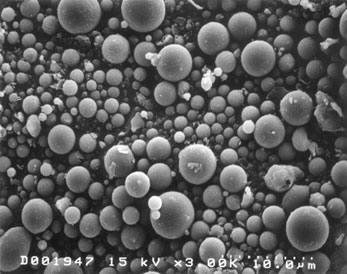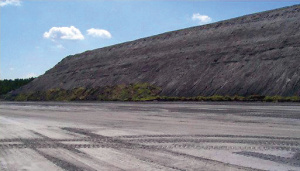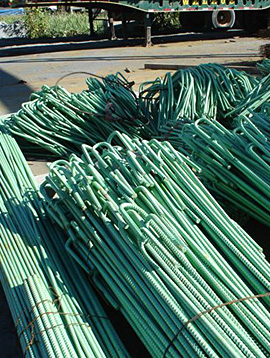Apr
6
A Way to Not Buy Concrete Again and Again
April 6, 2011 | 2 Comments
Making cement is a major use of natural gas. Then comes the transport, steel and other construction materials that usually are involved with concrete structures. Building things uses plenty of energy, and making them last has important implications.
Charles Carraher, Ph.D., explained at the 241st National Meeting & Exposition of the American Chemical Society last week that the more than 450 coal-burning electric power plants in the United States produce about 130 million tons of “fly ash” each year. Before air pollution laws, those fine particles of soot and dust flew up smokestacks and into the air. Power plants now collect the ash. What to do with all that?
Coating concrete destined to be rebuilt of America’s crumbling bridges and roadways with some of the millions of tons of ash left over from burning coal could extend the life of those structures by decades, saving billions of dollars of taxpayer money. The report on a new coating material for concrete made from fly ash is hundreds of times more durable than existing coatings and costs only half as much as some alternatives.
Getting use from that fly ash is a very good idea, and extending the life of the world’s infrastructure is a timely and valuable idea. If things last hundreds of times longer a lot less infrastructure will need rebuilt permitting a lot of new needs to be funded. This is good.

Fly ash Spill From The Kingston Fossil Plant. Click image for the largest view. Image credit Wikipedia.
Carraher explains from the pollution view saying, “Fly ash poses enormous waste disposal problems. Some of it does get recycled and reused. But almost 70 percent winds up in landfills every year, where space is increasingly scarce and expensive. Our research indicates that this waste could become a valuable resource as a shield-like coating to keep concrete from deteriorating and crumbling as it ages.” That would be 91 million tons, quite a pile. And when it gets a way, quite a mess.
The idea is better than the headline suggests. The new material can be used to coat and protect from corrosion the steel reinforcing bar, or “rebar,” rods embedded in concrete to reinforce and strengthen it. The coating also is suitable for repairing damaged concrete. Those two uses have great merit. Many sound contractors will order epoxy painted rebar at great expense to insure that structures won’t come apart from the pressure of unprotected rebar corroding and pressuring its way out of the concrete, cracking and undermining the strength.
The ACS press release isn’t specific on the repairing suggestion. Repairing can mean a very wide range of things. But even if the repair limit is just stopping degradation and/or water infiltration the usefulness is striking in the magnitude. Wear resistance, such as on a roadway isn’t mentioned, but if the idea can get to concrete surface reconstruction at less cost than asphalt, the idea has legs that might use up a bunch of the fly ash in inventory over time.
Carraher, who is with Florida Atlantic University is part of a joint project between industry with Felix Achille, of Blue World Crete and colleagues including Charles E. Carraher, Ph.D., Dept. of Chemistry and Biochemistry; Madasamy Arockiasamy, Ph.D., Dept. of Civil Engineering; and Perambur Neelakantaswamy, Ph.D., Dept. Electrical Engineering and Computer Science.
The laboratory tests report that the coating has excellent strength and durability when exposed to heat, cold, rain, and other simulated environmental conditions harsher than any that would occur in the real world. The coating protected concrete from deterioration, for instance, that involved exposure to the acids in air pollution that were 100,000 times more concentrated than typical outdoor levels environment. Coated concrete remained strong and intact for more than a year of observation, while ordinary concrete often began to crumble within days. This has powerful implications, particularly in China where building is at a furious pace and flyash accumulates even faster. Perhaps the winds won’t blow so much all around the world someday.
Carraher cited U.S. Environmental Protection Agency estimates for the cost for repair, restoration, and replacement of concrete in domestic wastewater and drinking water systems. They range up to $1.3 trillion, and by some accounts must be completed by 2020 to avoid environmental and public health crisis problems. Crumbling concrete roads and bridges will require hundreds of billions more. Those numbers are huge and imply a huge use of energy and taxpayer cash – saving any part with a net cash benefit is worth pursuing.
Carraher’s presentation at the ACS meeting keys that use of the coating could extend the lifespan of those structures, with enormous savings, while helping to solve the fly ash disposal problem. Actually let’s just save all the money we can and make our structures last longer. More info please, sirs.
Comments
2 Comments so far






Common sense dictates that you understand the ingredients for success before you commit time and
money to your project. Mulch mowers cut grass clippings twice into fine particles that fall through the turf and decompose quickly.
If you are an advanced individual with vast knowledge for
computers, you can purchase an advanced lawn mowing software.
Hello everyone, it’s my first go to see at this website, and piece of writing is truly fruitful designed for me, keep
up posting these content.